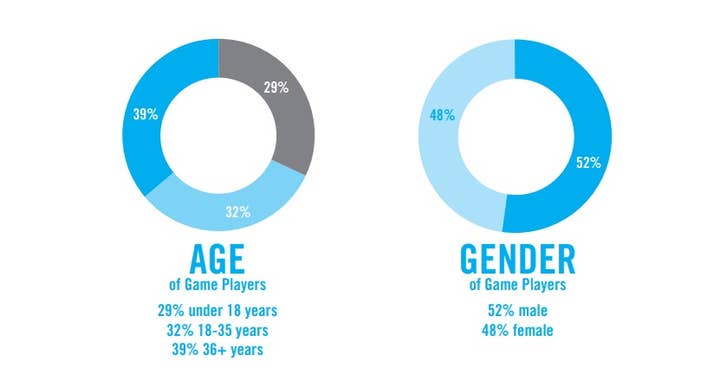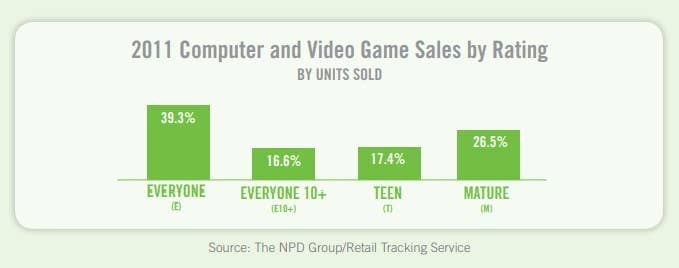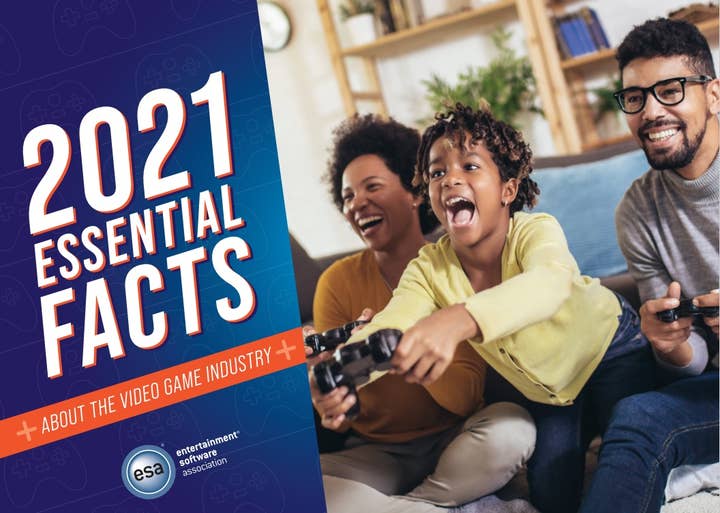Essential facts about the ESA's Essential Facts | This Week in Business
An entirely too frustrating attempt to chart industry trends through 15 years of the trade group's annual stats dump
This Week in Business is our weekly recap column, a collection of stats and quotes from recent stories presented with a dash of opinion and intended to shed light on various trends. Check back every Friday for a new entry.
The Entertainment Software Association this week released its annual Essential Facts data dump about the games industry.
While we've covered it as straight news before, we set it aside for This Week in Business because a lot of the numbers simply affirm the same things the trade group has been telling us for years -- and thus are arguably not news -- and just about everything else in there needs a subjective asterisk of some sort.
The ESA has been putting Essential Facts brochures together with the help of Ipsos surveys for well over a decade. They generally contain demographic factoids about who is playing games and how, as well as information about what a great job the industry does for parents, how everyone enjoys games, and how games bring people together in healthy ways. (The ESA is a trade group after all, so the cheerleading is to be expected.)

You might think that having these Essential Facts released year after year would be helpful for detailing long-term trends in games, and to a certain extent, they are. But the information given often changes in slight ways that thwart attempts to chart a nice, neat progression of any sort of trend.
For example, financial information about how much money the games industry bring in was originally a key part of the Essential Facts, which included NPD charts detailing historical sales growth. But in recent years, the ESA has downplayed mention of how lucrative games are, and excised the topic entirely from its release in the past two years.
Even on subjects the ESA sticks with year in and out, there can be issues. When we're lucky, the data provided in the reports click together and affirm things we basically knew already, like the idea that more people are gaming now than ever before.
STAT | 227 million - The number of American who played games in the 2021 Essential Facts report
STAT | 155 million - The number of Americans who played games in the 2015 Essential Facts report
The tracks with what we might generally think of as the growth in the US gaming audience, but we can't really draw a neat line for the year-to-year trajectory because only one of the five intervening reports (2020) gave that exact stat. 2019's report said there were 164 million adult gamers in the US, 2018's said 60% of Americans play games on a daily basis, while the Essential Facts in 2017 and 2016 gave the percentage of US households that own a device used to play games (67% and and 65%, respectively).
Still, the numbers seem to be going up, and that's the important thing, right?
Well, yes. But if we're having to rely on cherry-picked years for apples-to-apples comparisons, there's a greater chance of catching an outlier year. And one of the stats the Essential Facts gives somewhat reliably -- age of the average gamer -- is evidence that there can be significant variation from year-to-year.
STAT | 31 - The age of the average game player, according to Essential Facts 2021
STAT | 35-44 - The average age range of a video game player, according to Essential Facts 2020
STAT | 30 - The average age of a game player, according to Essential Facts 2012
STAT | 37 - The average age of a game player, according to Essential Facts 2011
There are also issues caused by trying to track the industry's successes -- which realistically should be one thing you hope these reports would capture -- like the growth of gaming among older people.
STATS | 7%, 9%, and 12% - The percentage of gamers who are over 65, 55-64, and 45-54, respectively, according to the 2021 Essential Facts report.
These sound like they would be very strong numbers for the industry, but it's tough to chart them because while the ESA has consistently reported age demographic information, it has been inconsistent in how it did that.
2020's report had the same pair of eldest age groups, but gave a 35-54 age range instead of the more limited one from this year's report. In 2019 and before, the top age groups were lumped together in a 50+ category.
In 2014, the ESA reported a top age group of 36+, which is shockingly unhelpful for charting the changing demographics but did allow the ESA to make the oldest category into the largest part of its demographic chart, beating out the 29% portion claimed by the under 18 years crowd and the 32% share of the those aged 18-35.

That's another thing to remember about these stats. As a trade group, the ESA wants to put the industry in a good light, and the numbers are going to be massaged in whatever way does that best. And if they don't put the industry in a good light, well, they might not stick around at all.
For instance, over a decade ago, the ESA used to regularly include a breakdown of computer and video game sales by rating, showing how large a chunk of the market each rating accounted for (by units sold). In the mid-2000s, games rated M for Mature represented about 15% of the market, which seemed acceptable for an industry fighting off legislative efforts rooted in the idea it was aggressively selling violent games to kids.
But the M-rated share of the market started to grow in 2009 and 2010. In 2011, M-rated games like Skyrim, Battlefield 3, Gears of War 3 and Mortal Kombat joined with successful annualized M-rated fare like Call of Duty: Modern Warfare 3 and Assassin's Creed Revelations to help push the M-rated market share all the way up to 26.5% of all games sold in the US. (The original Wii's late lifecycle likely contributed to this as well.)
The next year had another strong crop of best-selling M-rated titles with Halo 4, and Borderlands 2 joining a pair of Call of Duty titles and Assassin's Creed 3 to claim five of the top eight best-sellers of the year, and Mass Effect 3, Skyrim, and Battlefield 3 also landing in the top 20. Unfortunately, we don't know what the market share of Mature games was because the ESA stopped reporting that information in its Essential Facts pamphlet for that year. Instead, it told people what percentage of games received each rating, bringing the M-for-Mature category back down to a much more family-friendly 9%.

The ESA has actually been consistent in releasing these ratings breakdowns since then, but there's enough year-to-year variation that it's difficult to point to trends, other than perhaps a recent polarization in the ratings.
STAT | 49% - The percentage of games rated by the ESRB in 2020 that received an E for Everyone rating, the third straight year that percentage has gone up and the largest it has been since the ESA began including the stat in its Essential Facts.
STAT | 14% - The percentage of games rated by the ESRB in 2020 that received an M for Mature, the second straight year that percentage has gone up and the largest it has been since the ESA began including the fact in its Essential Facts.
Those numbers also mean the cumulative share of games rated T for Teen and E10+ for Everyone 10+ has been shrinking to their lowest levels since these stats were included in the Essential Facts releases.
So looking through these stats has given us a rough idea of where the US games industry is and how it's been growing, but there's one more pair of stats I want to highlight that provides a key part of the industry's growth story that isn't really highlighted anywhere in the Essential Facts piece.
STAT | 1,491 - The number of games the ESRB rated in 2016, the earliest year for which that information was included in Essential Facts.
STAT | 4,201 - The number of games the ESRB rated in 2020.
In case you're wondering, the intervening years showed a steady increase. And while the growth curve sharply plateaued from growth in the 30%-45% range to just 4% last year, the pandemic's impact on game development and publishing plans (and the industry's growth in spite of that) seems like a good reason to think that the explosion in the number of games being rated each year could easily resume if the pandemic is properly dealt with.
It's frustrating that I dug through the past 15 years of the ESA's Essential Facts releases (and a handful from ESA Canada to boot) to piece together a bigger picture from inconsistent annual snapshots for this, but the biggest takeaway I have here is the one that the ESA has always wanted the Essential Facts series to convey anyway:
The games industry is growing. It's bigger now than it has ever been before, in basically every way you might care to measure it.
QUOTE | "As a gamer, this is a product I've always wanted." - Gabe Newell hypes up Valve's newly announced handheld gaming PC, the Steam Deck.
STAT | 0 - The exact amount of demonstrable progress Amazon has made in responsible sourcing of conflict minerals over the past eight years, according to its conflict minerals disclosures. Also, the number of times Valve has responded to our requests for comment on their minerals sourcing since we started asked it about the subject three years ago.
QUOTE | "This lawsuit isn't about helping the little guy or protecting consumers. It's about boosting a handful of major app developers who want the benefits of Google Play without paying for it." - Google talks pretty tough for a company being sued by 37 US state and district attorneys -- including that of its home state of California -- for using monopolistic power and dominant market position to collect a 30% revenue share from developers.
STAT | 0.03% - As Google pointed out in a blog post sharing its side of the argument, less than one-third of 1% of developers are successful enough to pay a 30% revenue share to Google Play because they surpassed $1 million in earnings, the point at which Google's share jumps up from 15%. It might be an effective stat against the framing of this legislation as "helping the little guy," but it doesn't exactly make your ecosystem look like a great place for businesses to set up shop. (Kinda wild how the mobile game market is just whales all the way down, though.)
STAT | 70% - The amount of Stadia Pro subscription fees which will be split between development partners based on how often players are playing their games on the service. Google called it an "industry leading" revenue split for developers.
QUOTE | "We as a country accept that people over the age of 18 can gamble but let's make that for adults and giving parents a warning." - Australian MP Andrew Wilkie says next month he will introduce legislation requiring all games with loot boxes to carry an adults-only rating in the country.
QUOTE | "As an industry, I would love it if we came together to help preserve the history of what our industry is about so we don't lose access to some of the things that got us to where we are today and built this industry." - Phil Spencer emphasizes how vital it is that the biggest players in the industry put some effort toward preserving the history of the medium they have helped shape.
QUOTE | "It's really seductive to put single people up. It's also easier to say 'This person for everything.' I get that. It doesn't present well when you go, 'This person did this and this person did this and this person did this...' You want a clear approach." - Jumpship's Chris Olsen grapples with the problem of presenting himself as the creative vision holder behind Somerville while also fully acknowledging the contributions of the entire team.
QUOTE | "I remember the sinking feeling I had in my stomach after I found out GDC was going to announce they were cancelling the show. I ended up essentially retooling the entire announcement campaign strategy... for Sea of Stars from the PAX East show floor that Friday afternoon -- all from my phone." - Tinsley PR's Stephanie Tinsley is one of a number of PR professionals who told us about how the pandemic has changed the way games are promoted.
QUOTE | "I'm honoured to work with a company that's investing in women and betting on us to succeed." - WNBA star Candace Parker talks about being the first woman cover athlete for the NBA 2K series. Her cover will be exclusive to GameStop; other versions of the game feature Luka Doncic, Dirk Nowitzki, Kevin Durant, and Kareem Abdul-Jabbar on the cover.
STAT | 2 million - The number of copies the mobile version of Dead Cells has sold in China as a rare premium-priced game.
QUOTE | "We want to get the game in your hands as soon as possible so you can experience the unforgettable version of a haunted Tokyo that we've been hard at work building. At the same time, we're also focused on protecting the health of everyone at Tango. Our new release window will give us time to bring the world of Ghostwire to life as we've always envisioned it." - Tango Gameworks announces that it is delaying Ghostwire: Tokyo to next year.

